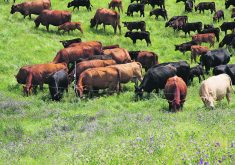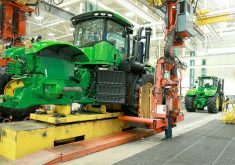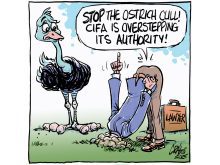Private health care
I strongly disagree with Peter Holle that “private facilities have (a) place in universal health care,” (WP, May 8). How can for-profit businesses possibly cost us less than well-run nonprofit facilities? Why would anyone, except possibly the rich, want a two-tier health-care system?
Mr. Holle spends considerable time extolling the virtues of the approach to health care taken by Spain, and the autonomous political institution of Catalonia in particular. He further claims the comparison is good because Spain’s demographics are similar to Canada’s.
Read Also

Budget seen as fairly solid, but worrying cracks appear
The reaction from the agriculture industry to prime minister Mark Carney’s first budget handed down November 4th has been largely positive.
I’m not a demographer, but is 14.8 percent of the population ages 0-14 (Spain; source: www.gencat.net/cidem/catalonia) “similar to” 18.4 percent (Canada; source: www.statcan.ca)? Or 13.4 percent ages 35-44 (Spain) similar to 16.9 percent (Canada)?
And should we be comparing a country of 39.9 million (Spain; source: www.who.int) or an autonomous region of 6.15 million (Catalonia; www.gencat.net) with a country of 31 million (Canada; source: www.who.int)?
The total expenditures on health care in 2000 as a percentage of GDP are not that different – 9.1 percent (Canada) and 8.2 percent (Spain) – not quite one percent difference (source: www.oecd.org), not the “almost two points” claimed by Mr. Holle. How does the smaller number of practicing physicians per thousand population – this wasn’t mentioned by Mr. Holle – in Canada (2.1; vs. 3.3 in Spain; source: www.oecd.org) figure into the picture? How do their salaries compare?
My point is that Mr. Holle’s numerical data are suspect, and I don’t believe that numbers tell the story anyway. We may very well be able to learn valuable lessons in health care from Spain, but I suspect that Mr. Holle’s attribution of the wonders of Catalan health care to the use of private facilities is overly simplistic….
I fervently support an efficient, public, equitable-access health-care system in which health professionals decide who receives care based on medical need.
The more privatization that occurs, the more we will see inequitable access as a result of insurance companies or the ability to pay deciding who receives what medical treatment.
– Scot Steele,
Edgerton, Alta.
Political promises
Which way will it be? The political pundits are at it again. Promises, promises. Scheming to bribe the electorate to gain its support. The question: can you fool all the voters all of the time, or just some of the time?
If I were to be the devil’s advocate and wanted to turn Canada into a socialist paradise, I think I would go about it like this.
I would cultivate among the people the idea that the individual is nothing and the indiscriminate mass of the people everything. I would also seek that an honest desire to make one’s own way in the world is old-fashioned.
I would get elected to office on the promise of helping everybody at someone else’s expense, on the backs of future generations. I would increase the size and scope of government in every way possible, going into every conceivable business in competition with established enterprises.
Paying the state business losses out of the treasury, I would try to keep hidden how this could lead at the right time to the nationalization of industry.
I would create a government strong enough to give its citizens everything they want; thus I could create a government strong enough to take from them everything they have.
By a combination of inflation and taxes, I would rob the very people I pretend to help until, if ever they should want to return to freedom, they couldn’t but would be completely dependent on the government.
Next, I would gradually raise taxes to 100 percent of income (we are more than half of the way there now) so that the government could have it all. Then I’d give back to the people enough to keep them alive and little enough to keep them enslaved.
In the meantime, I would take from those who have and give to those who want until I killed the incentive of the presently ambitious man and satisfied the meagre needs of the rest. The police state, with no private guns, would then be required to make everybody work, and the transformation of Canada from a free society, free enterprise system to a second rate communist nation would be complete.
Do you see in this any similarities to what we have been doing for years?…
Is there a fix for our political dilemma? History says yes.
That great civilization of old Naniwa, [who found] a captain that helped to steer back the ship of state, where justice reigned again. We could do it too….
– Geo. G. Elias,
Haskett-Morden, Man.
Media’s impact
Concerning mad cow disease, my heart goes out to all our cattle ranchers. My first question, being a elk farmer, is what’s hurting your industry more – the disease or the media?
At least you have the government and [Alberta premier Ralph] Klein’s support for the beef industry. We had nobody, not even Fish and Wildlife, and it’s left a lot of us very bitter people. Plus once the media was done with us, we were completely wiped out as a breeding industry, let alone a meat industry.
Next question for our government boys, since only one chronic wasting disease case versus one mad cow disease case, maybe they should start looking at us as agriculture and start opening the borders to us….
My next gripe is how that cow laid for three and half months before being looked at. Who did our government boys try to put the blame on? Of course, the elk industry. They were too busy examining elk and deer heads. Now they shafted the beef industry trying to pull the elk industry down.
If they were short on people, why weren’t more people hired? They have money to send to every country in the world and have none for research and to hire more people, scientists, etc., to solve our own problems concerning diseases.
But what they will do now is hear other people, at the cost to the taxpayer, to investigate the researchers to see where they fell down. For now they’re passing the buck onto the elk industry for not examining that cow.
I also find it amazing every elk that went down in Alberta and only one case of CWD to be found. If this disease spreads like wildfire, where is it, why doesn’t it show again? One cow, eight years old, exposed to hundreds of other animals, one animal out of thousands and the beef industry is shut down.
My advice to all you people out there: eat beef, this is cattle country. Eat elk, deer, buffalo. Don’t be frightened by the media.
Animals are like people, they get diseases, and some very strange ones for people, the latest, Severe Acute Respiratory Syndrome. Well, diseases appear in animals as well. …
– Beverly Lein,
Manning, Alta.
Raising hogs
I will begin this letter by praising Greg and Bonnie Spragg of Rosemary, Alta. They are raising hogs outdoors. That makes you good stewards of land, air, water and environment in my book.
I am also pleased to hear the consumers in their area are supporting the Spraggs, because as we know, the mega hog operators are squeezing out the small operators. I have not purchased fresh pork at supermarkets or ordered it as food in a restaurant for many years because the flavour or odour is not acceptable to me.
I also found the letter by Delwyn J.J. Jansen of LeRoy, Sask. interesting (Open Forum, May 1.) His idea of building a hog barn in the heart of Saskatoon.
Well, I also have an idea. I think they should build a hog barn by provincial legislature buildings. There’s plenty of water from Wascana Creek. The hog manure could be used as fertilizer on all that grass, but most importantly, all the politicians could keep up with the developments of this great rural revitalizing plan for rural residents.
Also, the city cousins would be able to enjoy the same atmosphere as their country cousins….
The greatest problem and threat to our country living is our provincial government and the multimillions they are giving for all the mega hog operators. The local developers are only interested in the multi-millions they will be able to access. For instance, the local developers of Quill Lakes area are proposing along with Big Sky Hog Farms to construct a 5,000 sow hog operation in their ecologically sensitive wildlife area, which has become well known by the tourist trade.
Why would anyone living in this area want to destroy what they already have just to gain some taxpayers’ dollars for a very few people?…
It is time that mega hog operators and government departments started to insist on environmentally friendly methods of intensive livestock operations. The guidelines need to be changed to improve the land, air, water and environment in our rural area. Present practices are destroying all of the above and at what cost to the people’s health?
There are safer methods of raising hogs.
– Pauline Lapitsky,
Theodore, Sask.
Election time
As we are aware that election time is now coming up, provincial and federal, what kind of carrot on the stick will they impose to get your vote so they can take the reins of power?
You know who brought in the GST. When (prime minister Jean) Chrétien was in opposition, he [said he would] dispose of the GST. When he took over the reins of power we still have it, a golden egg. So they can play golf in Florida.
The provincial fellow thought, ‘gee, it sounds good so we’ll put on the PST’, the dirtiest tax that was ever put on the public.
When will we get an honest government to run our affairs?
– Bernard Schreiner,
Naicam, Sask.
Mad cow
I am so mad about mad cow disease, I don’t know where to start.
First of all, I am appalled that animal byproducts are still being fed to other animals that are going to be part of the human food chain, especially after we saw the problems it has caused in Europe.
And living in Canada where forage and grains are so plentiful [that] the prices are often too low for producers to make a living, there is absolutely no excuse for using healthy or sick animal byproducts for feed….
Now for our city cousins, let me explain the irony of this a little better. Rendering plants get paid by the farmer to remove a dead animal. It then sells the byproducts to pharmaceutical, cosmetic and feed companies.
Now if I had that sweet of a business going, I would lay low, keep my mouth shut. But these guys have the boldness after one cow is diagnosed with mad cow disease to ask for a bailout….
The fact is farmers have had dump sites for years where they have dumped sick animals and the coyotes will eat those carcasses, clean hair and all.
And I have yet to see the coyote population wiped out by disease or I’ve yet to see one dead without a bullet in him.
And that is because that is exactly where this food should be going, to the dogs. I will give my dog a nice, clean bone and he will bury it until it is rotted to his liking or he will drag a cow head onto our lawn from some diseased animal that the neighbour dumped and will enjoy it to the last morsel. Dogs can eat what would kill most other animals.
Yet go to the store and try to buy your dog or cat a bag of food where meat or meat byproducts are the first ingredient. And 90 percent of the food will not ….
I am told since 1997 Alberta did ban the feeding of sheep and cattle byproducts back to the same. But if that is the truth, why was there a big scramble to find out which farmers got the remnants of this sick cow in their feed? And why were there herds put under quarantine? This crisis poses some serious questions which the public should be demanding answers for…..
I hope this letter gets printed in its entirety and gets people as upset as they should be. But make sure you put your anger where it belongs, certainly not on the farmer. Most farmers take excellent care of their animals and take great pride in raising a healthy herd.
Put the pressure on the politicians involved in the decision making.
To me the answer is simple: put the byproducts from rendering plants into dog and cat food. Let the feed companies buy more feed off of the farmers who have always struggled with low commodity prices. We’d have healthy and happy cows, dogs, cats and farmers.
If this answer seems much too simple for you bureaucrats out there, you may have the education but I have the one thing you lack: common sense.
– Ron Taks,
Bowden, Alta.
Wake-up call
(Re: May 29 WP editorial.)
We live in a world gone mad. Our biggest trading partner is led by a president who believes that his election was a victory for democracy and yet would have denounced such election behaviour in a non-democratic country as an illegal communist/terrorist plot.
Our neighbour to the south abhors terrorism and yet supports the murder of over 40,000 of its citizens annually as a constitutional right to bear arms.
This country, the land of the brave and home of the free, believes because of its massive military strength, it is above the laws of this world and will invade any country that threatens its energy supplies.
Should Canadians, with their vast reserves of natural resources, be afraid? Of course not. After all, we have free trade. Free trade that is on their terms, terms which change independent of the North American Free Trade Agreement and the law.
The present BSE [bovine spongiform encephalopathy] crisis in Canada should be a wake-up call to Canadians as it not only is devastating to the cattle industry in Canada, but it has allowed the Americans to be punitive at the border in response to our unwillingness to send troops to Iraq, thus violating international laws. Do I know this for sure? No. Perhaps I am jumping to conclusions.
As a partner in a small but rapidly growing pet food company with sales primarily in the United States, we have had no problems up until now sending product to our distributors south of the border.
I can understand the rationale behind closing the border to our beef product.
But to turn back our chicken, which up until May 29 has never had a problem crossing the border, because it may contain chickens that were fed tainted meat or bone meal and this expensive 10 pounds of dog food might find its way into cattle feed, is nothing short of harassment.
– Meg Smart,
Saskatoon, Sask.
Migrant workers
(Re: Migrant workers union voices concerns, WP, Nov. 1, 2001.)
I am alarmed to read that some migrant workers come to Canada for up to 11 months out of a year. What does this do to their families back home?
I would love to bring my cousin from Poland to Canada. He’s worked all over Europe on various harvesting efforts and would love to live and work in Canada. But what kind of a life would he have?
How can the Canadian government say “we need you to do some work nobody else wants” for most of the year but “leave your family behind because we don’t really want them or you, just your sweat in our fields”?
Especially in Saskatchewan, when we have this population drain, I find it alarming that our government makes it so impossible for me to sponsor my cousin and make it legal for him to find work here.
In what way are we being moral in our immigration policies?
– Delila Hesketh,
Bienfait, Sask.














